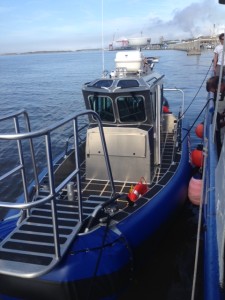I have a new favorite thing: tagging whales.
This field season, I am working on a tagging project led by Dr. Doug Nowacek (Duke Marine Lab) with our very own Dr. Susan Parks as the Co-PI. The project aims to track as many right whales as we can to figure out just what they are doing and where they do it in Florida. The project is particularly timely given the Navy’s plans to use an undersea warfare training range adjacent to the winter calving grounds. The tags allow us to get more detailed information than vessel-based or aerial surveys alone, and the data allow the Navy to increase their understanding of how the right whales use this habitat and how to mitigate the effects of their training range.

So where do I fit in? Well, wherever is most helpful. I am here to learn everything I can about using DTAGs, including programming, downloading, and deploying. Yesterday we went out in search of whales and found a mother/calf pair. As per usual with right whales in the Southeast, they were keeping a low profile—we first saw the calf’s back just barely visible above the water about 500 meters away. With the warm air, it’s hard to look for the distinctive V-shaped blow, so we need to rely on other cues such as the broad black back of an adult or any white water created by a whale “speeding” by at 2-3 knots.
Once we caught up with the pair, we realized that they weren’t really traveling in a single direction, making them somewhat unpredictable. We had some helpful spotters in a survey plane above us to give us an ID for the mom (NARWC #2645) and keep track of the whales for a while, and eventually we made a tagging attempt. The whales sank down at exactly the wrong moment, remaining untagged.
At one point, the calf surfaced very close to the boat, and Matt, a grad student at Duke, got a great shot of its little face! Or very large face as the case may be.

So the whales got to keep some of their secrets for at least another day, but hopefully the fog will clear this afternoon so we can find some more whales!
–Jess